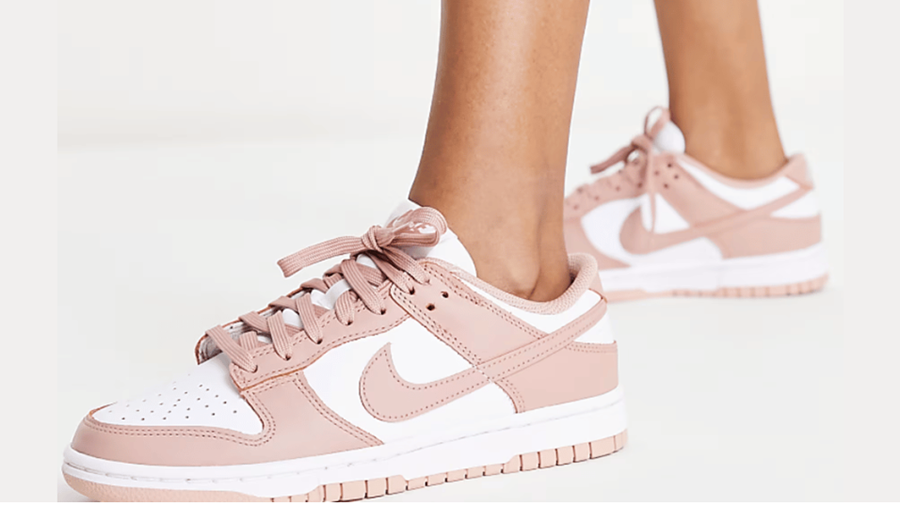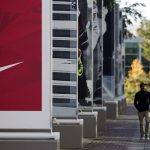Nike, Inc. is expected to meet or exceed conservative guidance when it reports earnings for the fiscal fourth quarter ended May 31 on Thursday evening, June 24; however, the results are likely to remain well below year-ago levels. Many analysts remain skeptical that Nike officials will indicate that a return to growth is imminent.
The Zacks Consensus Estimate for fiscal fourth-quarter revenues is pegged at $10.7 billion, suggesting a 15.4 percent decline from the year-ago fourth quarter’s reported figure. The EPS estimate for the quarter is 11 cents per share, compared to $0.99 in the comparable year-ago quarter.
Investors are more interested in Nike’s guidance for the current fiscal first quarter ended August 31, to see whether efforts to rebalance inventories for its Classic franchises — The Dunk, Air Force One, Jordan 1 — and the company’s push to recapture shelf space at wholesale are making headway.
Nike Dunks in the pink colorway, pictured in the lead image, are currently on sale for $69.20, down from their original MSRP of $115.
Other key investor focuses include looking for signs of a rebound in the sluggish China region.
The current analysts’ consensus estimate for the fiscal first quarter is $0.32, down from $0.70 a year ago. Sales are expected to reach $10.7 billion, representing a 7.6 percent year-over-year decline.
Investors will also be eager to hear a tariff update on the company’s quarterly analyst call. Nike has not provided details on the likely impact of tariffs or its mitigation strategies since its last quarterly call on March 20 before President Trump’s administration announced its tariff plan in early April.
Finally, investors will be looking for any indication of forward-looking guidance. Although Nike suspended its FY25 guidance during the fiscal Q1 earnings call last October, in light of extensive turnaround steps following the appointment of Eliot Hill as CEO, analysts do not expect the company will provide FY26 guidance.
Matt Powell, veteran footwear analyst and advisor at Spurwink River and BCE Consulting, believes the fourth-quarter analyst call will show that the company is making slow progress.
“I think Nike is doing all the right things to turn the business, but all the initiatives will take time,” said Powell. “I expect to see a continued challenged top line and an improving bottom line, with cautious (or no) guidance.”
In its preview note released on June 18, Barclays, which has a “Neutral” rating on Nike, lowered its FY26 and FY27 estimates for Nike and its price target to $53 from $60.
“We remain cautious heading into FY4Q25,” said Barclays analyst Adrienne Yih. “We expect ongoing ‘franchise life cycle management,’ return to wholesale, tariffs, and China risk will weigh on FY26 performance. We would get more constructive if sales-to-inventory growth inflects positively (we forecast FY3Q26) or estimates are de-risked.”
Yih said she believes the investor focus for the fiscal fourth quarter will be on first-quarter sales trends, the tariff impact and mitigation strategies, and expectations for FY 2026.
“Specifically, we look for evidence that reset actions have begun to materialize in results, what CEO Elliott Hill plans to execute in FY26, and the timing for when further actions should provide upside to estimates,” wrote Yih.
Yih said that to date, Hill has accelerated the product newness cycle, innovation engine and marketing under its “Win Now” strategy; however, she said Nike is “emerging from a deep hole from prior management in terms of excess inventory, lack of innovation, and brand equity, which we expect will take multiple seasons to correct.”
She suspects that the cleanup of franchise classics inventory will extend into the second half of Nike’s current fiscal year to pressure sales and margins. She does not foresee a turnaround, which she expects will be led by wholesale, until the second half of the fiscal year at the earliest.
Yih wrote, “Despite a turnaround strategy that is executing on management’s internal plan, we see more pressure in the near term, which could be exacerbated by the overhang of tariff pressures and demand uncertainty on the 1-year horizon given the still unproven customer response to new product debuting in fall/holiday 2025. We also believe frontline retail may take a more conservative, measured inventory position for the fall season.”
At Citi, Paul Lejuez, who has a “Neutral” rating on Nike with a price target of $57, expects the company to exceed analyst targets for the fourth quarter, driven by slightly stronger sales and lower SG&A expenses. He does not expect Nike to offer FY26 guidance, given the ongoing macroeconomic uncertainty and Nike’s extensive turnaround efforts.
For the first quarter, Lejuez expects Nike’s sales to be down in the high-singles to low double-digits. He expects EPS for the first quarter to be guided to about 10 cents a share, well below Wall Street’s consensus target of 39 cents, due to continued sales and gross margin pressure from its classic franchise clearance efforts.
Lejuez suspects Nike officials will indicate that headwinds from classic franchise management will begin to abate in the second half of fiscal 2026.
Lejuez added, “However, the timing of NKE achieving enough innovation at scale across performance/lifestyle to drive sustainable topline growth is still uncertain and will be a focus of the call. Any sign that NKE can return to topline growth in late F26 would be a positive for shares given negative sentiment.”
At William’s Trading, Sam Poser, who has a “Buy” rating on Nike at a $73 price target, believes Nike’s Q425 results will likely meet or exceed guidance but said guidance going forward from the company will likely be limited until the impact from tariffs and the response to new product introductions “becomes clear.”
On the positive side, Poser believes Nike’s overall cleanup of the marketplace will be complete, except in China, by September, at the end of the back-to-school selling season. He forecasts a “small positive inflection” in Nike’s year-over-year revenue by the fiscal second quarter ended October as William’s Trading’s proprietary checks continue to indicate that many of the brand’s U.S. wholesale partners are planning Nike purchases up mid-to-high single digits, led by footwear.
Also expected to improve full-price selling by the October quarter is Nike’s refocus on core product, or footwear priced under $100 and mainly sold in the family footwear channel, on top of the introduction of “compelling“ new product, including the Pegasus Premium, Vomero Plus and Vomero Premium in the U.S., and the ST Flare in China, according to Poser.
Poser also sees revenue opportunities, as Nike has started shipping products to many accounts that were exited under the prior CEO’s administration, including Urban Outfitters, Shoe Show and Amazon.
Poser remains confident that Hill is slowly guiding Nike back to a “pull model,” with margin improvement likely to be followed by an acceleration of sales trends. Said Poser, “Mr. Hill clearly understands that Nike needs to reestablish its category offense, which is now called fields of play, in order to efficiently develop compelling product offerings. Nike is also beginning on the path to once again becoming the best grassroots marketing company out there, using the information gathered at the local level to create compelling products and tactically manage and market the Nike brand and its key franchises with a focus on sport. While these efforts will take time and will be painful in the short term, they could not have occurred under the prior administration.”
Stifel Financial’s Jim Duffy, who has a “Hold“ rating at a $65 price target on Nike, believes Nike will be able to at least meet analyst estimates in what he described as a “messy quarter,“ citing timing shifts, tariff actions and the brand’s efforts to clean up inventory. The analyst said, “Investors will be focused on capacity for a sustainable return to revenue growth and margin expansion for which visibility remains challenging. Lifestyle footwear product concentration in North America and Greater China persists and weighs on near-term visibility to inflection with refreshed product.”
Duffy suspects Nike’s officials will guide “conservatively“ for the current quarter. He sees the potential for Nike to achieve flat revenues for the current fiscal year, with an operating margin of 7.5 percent, equal to the projected operating margin for FY25. Said Duffy, “With near-term headwinds, we look to credible building blocks for FY27E earnings power to substantiate valuation. While we believe the business is capable of mid-teens operating margin over time, the lynchpin to this is incremental revenue driven by high-quality growth (not just expanded distribution).”
Image courtesy ASOS/The Freebie Guy
















